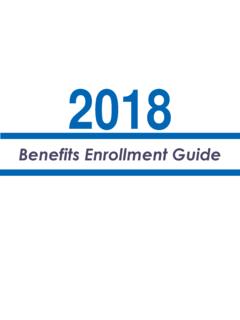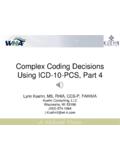Transcription of Commission on Narcotic Drugs and Commission on Crime ...
1 Commission on Narcotic Drugs and Commission on Crime Prevention and Criminal Justice general information on draft resolutions and draft decisions This information note contains: (i) Frequently Asked Questions (ii) Practical tips how to prepare draft resolutions and procedures (iii) Wording used in draft resolutions and draft decisions: practical tips and examples (i) FAQs: What are draft resolutions and decisions? draft resolutions and decisions are proposals submitted by member states of the Commissions, or by a member state representing a Group ( EU, GRULAC etc.) (called the sponsors ) for consideration by the Committee of the Whole and adoption by the Commission . The symbols of the draft resolutions and decisions contain the letter L because of their Limited distribution symbol (therefore, they are often informally referred to as L s ).. What is the correct procedure for submitting draft resolutions and decisions? draft resolutions or decisions can be transmitted to the Secretariat by email, provided that they are officially submitted under the cover of a note verbale from the Permanent Mission (the text of proposal should always be in WORD version).
2 A signed print copy of the proposal can also be handed over to the Secretariat as long as an electronic version of the draft proposal is provided as well. If a Member State submits two language versions of a proposal, it must indicate which language is to be considered the original version on which the translation will be based. Interested countries may sponsor draft resolutions by signing the appropriate sponsorship list available in the Secretariat of the Commissions, as well as by indicating their sponsorship of draft resolutions by raising their name plates either during the discussion in the Committee of the Whole or during the adoption in the plenary. draft resolution or draft decision ? What is the difference? There is often confusion as to the difference between a resolution and a decision . They are equal in legislative standing, and both require the formal adoption by the intergovernmental body. A few rules of thumb on the distinction between the two A.
3 Resolutions are formal expression of the opinion or will of the United Nations organs. They generally have two distinct sections, with a preamble followed by an operative part. - In the preambular part of a resolution , each paragraph is set out individually and begins with an italicized participle or adjective ( recalling, taking note of, having considered, welcoming, concerned, determined, aware). Those paragraphs are not numbered in the text and are normally referred as first preambular paragraph , second preambular paragraph and so forth. Introductory paragraphs may be referred to as the chapeau . - Operative paragraphs in a resolution , each of which begins with an italicized active verb in the present tense ( endorses, calls upon, reaffirms, invites) are numbered sequentially. They are referred to by their cardinal number (paragraph 1, paragraph 7, etc.). There are no bis or ter paragraphs. - A resolution may also contain subparagraphs, with (a), (b), (c) etc.
4 Used to denote them. B. Decisions are used to designate formal actions, other than resolutions, dealing with procedural matters, including but not limited to elections, appointments, the time and place of meetings, the taking note of reports and provisional agendas. - Should a decision need to be divided into separate subparagraphs, they are indicated as (a), (b), (c) etc. following a single operative verb. In a draft decision , that verb decides, endorses, etc. is always in the present tense. - Decisions are often used as the means whereby by a parent body, for example the Economic and Social Council, endorses or otherwise approves legislative action by a subsidiary body, such as one of the functional commissions that reports to it. Deadlines for submission of draft resolutions In accordance with Commission on Narcotic Drugs decision 55/1, and Commission on Crime Prevention and Criminal Justice decision 21/1, the firm deadline for the submission of draft resolutions is, in principle,1 four weeks prior to the commencement of the Commissions at noon.
5 Each year deadlines are proposed by the extended Bureaux of the Commissions and subsequently endorsed by the Commissions. The deadlines for submission are included in the annotated provisional agendas for the sessions and in the official invitations sent to Member States to participate in the sessions of the Commissions. Introduction of draft resolutions In accordance with past practice, the sponsor will introduce the draft proposal, in the Committee of the Whole (COW) (a technical committee of the Commissions, where resolutions are discussed and approved before they are submitted to the plenary for adoption), indicating amendments and additional sponsors, as necessary. The Secretary of the COW consults with the delegation on the timing of that introduction, coordinating it with the date of issuance of the draft text in all languages. Proper procedure would indicate that no informal consideration of a draft proposal can take place prior to its introduction.
6 However, to allow greatest flexibility and use of the limited time allocated to the COW, sponsors, together with interested delegations, may begin informal negotiations on draft resolutions before they have been circulated in the six official UN languages or introduced, as long as the extended Bureau and the Commission are informed and agree. 1 At its reconvened twenty-third session, in December 2014, the Commission on Crime Prevention and Criminal Justice decided that the deadline for the submission of draft resolutions would be two weeks prior to the commencement of its twenty-fourth session, on an exceptional basis, in view of the date of the conclusion of the Thirteenth Congress on Crime Prevention and Criminal Justice. Furthermore, delegations have the opportunity to introduce and discuss the draft resolutions that have been submitted, at informal pre-session consultations. According to rule 52 of the rules of procedure of the functional commissions of ECOSOC, proposals and substantive amendments shall be discussed no earlier than twenty-four hours after copies have been circulated to all members, unless the Commission decides otherwise.
7 This is called the 24-hour rule , which is understood to apply from the time the document is officially circulated. At the same time, given the five-day duration of their sessions, the Commissions may interpret this rule in a pragmatic and flexible manner. Withdrawal of draft resolutions Any draft proposal on which the sponsor wishes that no action be taken must be withdrawn by sponsoring delegation during a formal meeting. Statements of financial implications Should the implementation of a draft resolution require additional resources from the United Nations budget, a transfer of resources within the budget (so called "programme budget implications" or PBI ) or extrabudgetary resources, delegates participating in the COW are informed accordingly already during the negotiation phase. In addition, at the plenary meetings of the Commissions, prior to the adoption of each draft resolution , a representative of the Financial Resources Management Service of UNODC will read out a statement of financial implications.
8 All the statements of financial implications will be made available after the end of the session in a conference room paper, which will be posted on the relevant Commission webpage. Adoption of draft resolutions At the time of adoption in the plenary, the Secretary of the Commission takes note of the amendments, if any, made by the sponsor of the draft or suggested by other delegations (and approved by the sponsor). If the changes are significant, the Secretary will request the delegation to submit the amended or added text in writing. Delegations that wish corrections to be made to other language versions are also requested to submit them in writing to the Secretary, after introducing them from the floor. Those corrections will be reflected in the final report on the sessions of the Commissions. (ii) Practical tips how to prepare draft resolutions and procedures Preparation and submission of draft resolutions: The draft should contain the following: (a) Indication of sponsor(s) (b) Title of draft resolution (c) Body that is expected to adopt: the Commission , or the ECOSOC, or the GA; (d) Item of the agenda to which the subject refers to.
9 Preamble and operative paragraphs (see annex). If a proposal is submitted in two language versions ( Spanish and English), the sponsor should indicate which is the original version on which the translation will be based. The draft resolution should be submitted in an electronic Word version as well. Once a proposal is officially submitted to the Secretariat, it will be sent for editing and translation. The edited and translated proposal will be officially issued as L. document ( # or #), which means in-session document and limited distribution. Should the main sponsor delegation wish to amend an already distributed draft resolution , the electronic edited version should be requested from the Secretariat. Changes need to be clearly indicated by using track-changes mode. Procedures for consultations on draft resolutions during the session: The main sponsoring delegation presents a proposal to the COW; thereafter it is open for discussion and negotiation.
10 After it is discussed in the COW, it is presented to the plenary for adoption. If no agreement is reached and further negotiations are required, the Chair of the COW may invite the main sponsor to meet informally with interested parties and revert back to the COW with the negotiated text. All changes have to be incorporated in track-changes mode in the final edited text. The Chair decides the time when the newly negotiated text is to be reconsidered in the COW, depending on the work of the Committee. If the newly negotiated text has undergone significant changes, the Chair may decide that it should be sent for official revision (L.# ), which means it is submitted again for editing and translation. If possible, the issuance of a revised text that has not yet been approved by the COW in an official document should be avoided to the extent possible, as it would delay its final negotiation in the COW. If the COW approves a proposal with minor changes, the original text will be sent to the plenary for adoption and the Secretary will read out the changes, which will be only reflected in the final report on the session.


















